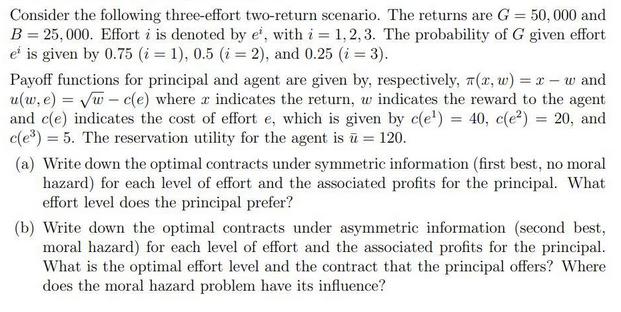Answered step by step
Verified Expert Solution
Question
1 Approved Answer
Consider the following three-effort two-return scenario. The returns are G = 50,000 and B = 25,000. Effort i is denoted by e', with i

Consider the following three-effort two-return scenario. The returns are G = 50,000 and B = 25,000. Effort i is denoted by e', with i = 1,2,3. The probability of G given effort e is given by 0.75 (i = 1), 0.5 (i = 2), and 0.25 (i = 3). Payoff functions for principal and agent are given by, respectively, (x, w) = x - w and u(w, e)=w-c(e) where x indicates the return, w indicates the reward to the agent and c(e) indicates the cost of effort e, which is given by c(e) = 40, c(e) = 20, and c(e) 5. The reservation utility for the agent is u = 120. (a) Write down the optimal contracts under symmetric information (first best, no moral hazard) for each level of effort and the associated profits for the principal. What effort level does the principal prefer? (b) Write down the optimal contracts under asymmetric information (second best, moral hazard) for each level of effort and the associated profits for the principal. What is the optimal effort level and the contract that the principal offers? Where does the moral hazard problem have its influence?
Step by Step Solution
There are 3 Steps involved in it
Step: 1

Get Instant Access to Expert-Tailored Solutions
See step-by-step solutions with expert insights and AI powered tools for academic success
Step: 2

Step: 3

Ace Your Homework with AI
Get the answers you need in no time with our AI-driven, step-by-step assistance
Get Started


